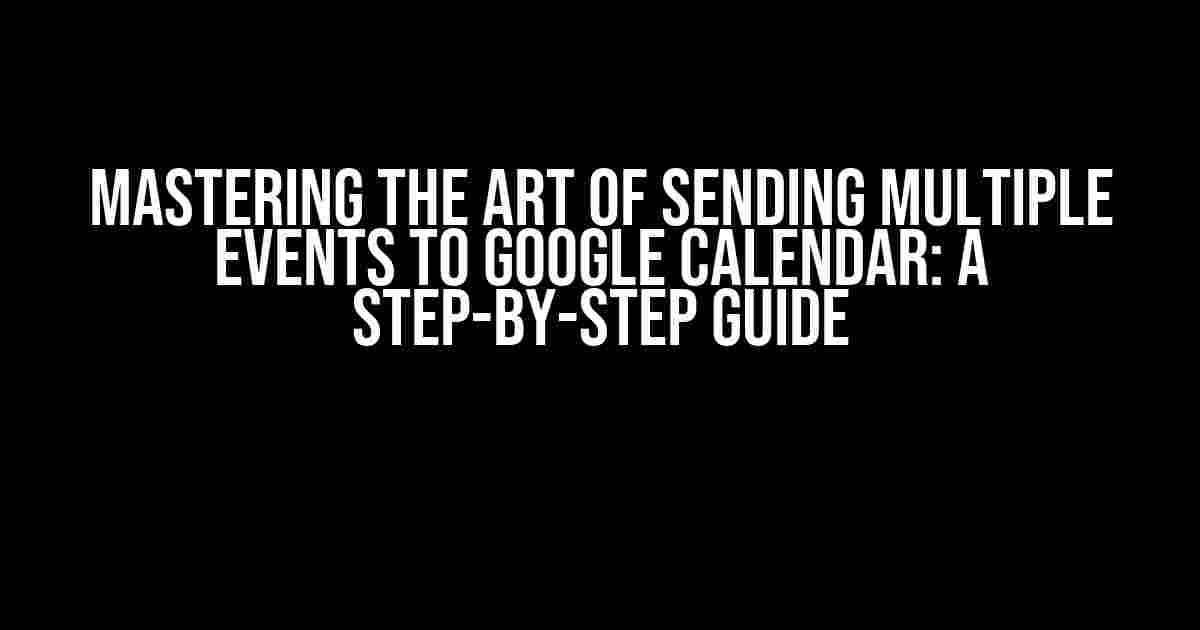Are you tired of manually creating events on Google Calendar, one by one? Do you wish there was a way to send multiple events to Google Calendar at once, saving you time and effort? Well, you’re in luck! In this comprehensive guide, we’ll take you through the process of sending multiple events to Google Calendar using various methods. Buckle up, and let’s dive in!
Understanding Google Calendar’s API
Before we begin, it’s essential to understand how Google Calendar’s API works. Google Calendar provides an API that allows developers to create, read, update, and delete events programmatically. To use the API, you’ll need to create a project in the Google Cloud Console, enable the Google Calendar API, and obtain credentials to authenticate your requests.
If you’re new to Google Cloud, don’t worry! Follow these simple steps to get started:
- Go to the Google Cloud Console and create a new project.
- Click on “Enable APIs and Services” and search for “Google Calendar API.”
- Click on the result, then click on the “Enable” button.
- Create credentials for your project by clicking on “Create Credentials” and selecting “OAuth client ID.”
- Choose “Other” as the application type and give your client ID a name.
- Copy the client ID and client secret, as you’ll need them later.
Method 1: Using Google Apps Script
One of the easiest ways to send multiple events to Google Calendar is by using Google Apps Script. With Apps Script, you can create a script that will automatically add events to your calendar based on a Google Sheets document.
Here’s an example script that will add multiple events to Google Calendar:
function addEventsToCalendar() {
var sheet = SpreadsheetApp.getActiveSheet();
var calendarId = "your_calendar_id";
var calendar = CalendarApp.getCalendarById(calendarId);
var events = [];
var rows = sheet.getDataRange().getValues();
for (var i = 1; i < rows.length; i++) {
var row = rows[i];
var title = row[0];
var startDateTime = row[1];
var endDateTime = row[2];
var description = row[3];
var event = {
"summary": title,
"location": "",
"description": description,
"start": {
"dateTime": startDateTime,
"timeZone": "America/New_York"
},
"end": {
"dateTime": endDateTime,
"timeZone": "America/New_York"
},
"reminder": {
"method": "email",
"minutes": 24 * 60
}
};
events.push(event);
}
calendar.createEvents(events);
}
This script assumes you have a Google Sheets document with the following structure:
| Event Title | Start Date Time | End Date Time | Event Description |
|---|---|---|---|
| Event 1 | 2023-03-01 10:00:00 | 2023-03-01 11:00:00 | This is event 1 |
| Event 2 | 2023-03-02 14:00:00 | 2023-03-02 15:00:00 | This is event 2 |
To use this script, simply create a new Google Sheets document, paste the script into the script editor, and run the `addEventsToCalendar()` function.
Method 2: Using Python and the Google API Client Library
Another way to send multiple events to Google Calendar is by using Python and the Google API Client Library. This method requires a bit more programming knowledge, but it's still relatively easy to implement.
First, you'll need to install the Google API Client Library using pip:
pip install google-api-python-client google-auth-httplib2 google-auth-oauthlib
Next, create a new Python script and import the necessary libraries:
import os import datetime import pickle import google.auth from googleapiclient.discovery import build from google_auth_oauthlib.flow import InstalledAppFlow from google.auth.transport.requests import Request
Then, set up the authentication flow:
SCOPES = ['https://www.googleapis.com/auth/calendar']
flow = InstalledAppFlow.from_client_secrets_file('credentials.json', SCOPES)
creds = None
if os.path.exists('token.pickle'):
with open('token.pickle', 'rb') as token:
creds = pickle.load(token)
if not creds or not creds.valid:
if creds and creds.expired and creds.refresh_token:
creds.refresh(Request())
else:
creds = flow.run_local_server(port=0)
with open('token.pickle', 'wb') as token:
pickle.dump(creds, token)
service = build('calendar', 'v3', credentials=creds)
Finally, create a function to add events to Google Calendar:
def add_events_to_calendar(events):
for event in events:
event = {
'summary': event['title'],
'location': '',
'description': event['description'],
'start': {
'dateTime': event['start_date_time'],
'timeZone': 'America/New_York'
},
'end': {
'dateTime': event['end_date_time'],
'timeZone': 'America/New_York'
},
'reminder': {
'method': 'email',
'minutes': 24 * 60
}
}
service.events().insert(calendarId='primary', body=event).execute()
You can then call this function with a list of events:
events = [
{
'title': 'Event 1',
'start_date_time': '2023-03-01 10:00:00',
'end_date_time': '2023-03-01 11:00:00',
'description': 'This is event 1'
},
{
'title': 'Event 2',
'start_date_time': '2023-03-02 14:00:00',
'end_date_time': '2023-03-02 15:00:00',
'description': 'This is event 2'
},
# Add more events here
]
add_events_to_calendar(events)
Method 3: Using Zapier or IFTTT
If you're not comfortable with coding, don't worry! You can use Zapier or IFTTT to send multiple events to Google Calendar without writing a single line of code.
Zapier is an automation tool that allows you to connect different apps and services. Here's how you can use Zapier to send multiple events to Google Calendar:
- Sign up for a Zapier account and create a new zap.
- Choose Google Sheets as the trigger app and select the spreadsheet you want to use.
- Select the range of cells that contain the event data.
- Choose Google Calendar as the action app and select the calendar you want to add events to.
- Map the event data from Google Sheets to the corresponding fields in Google Calendar.
- Test and enable the zap.
IFTTT (If This Then That) is another automation tool that allows you to connect different apps and services. Here's how you can use IFTTT to send multiple events to Google Calendar:
- Sign up for an IFTTT account and create a new applet.
- Choose Google Sheets as the trigger service and select the spreadsheet you want to use.
- Select the range of cells that contain the event data.
- Choose Google Calendar as the action service and select the calendar you want to add events to.
- Configure the action settings to add events to Google Calendar.
- Save and enable the applet.
Conclusion
Sending multiple events to Google Calendar can be a daunting task, but with the right tools and techniques, it can be a breeze. Whether you're a programmer or not, there's a method that suits your needs. From Google Apps Script to Python and the Google API Client Library, Zapier, and IFTTT, we've covered it all.
Remember to always follow the official Google Calendar API documentation and terms of service to ensure that your implementation is secure and compliant. Happy automating!Frequently Asked Question
Get all your questions answered about sending multiple events to Google Calendar!
How do I send multiple events to Google Calendar at once?
You can send multiple events to Google Calendar by using the "Batch" feature in the Google Calendar API. This allows you to create, update, or delete multiple events in a single API request. You can also use third-party tools or software that integrate with Google Calendar to send multiple events at once.
What is the maximum number of events I can send to Google Calendar at once?
According to the Google Calendar API documentation, you can send up to 50 events in a single batch request. However, it's recommended to keep the batch size smaller (around 10-20 events) to avoid timeout errors and ensure faster processing.
Can I send recurring events to Google Calendar in bulk?
Yes, you can send recurring events to Google Calendar in bulk using the "Recurring events" feature in the Google Calendar API. You can specify the recurrence pattern and the number of occurrences for each event. However, keep in mind that the recurrence pattern is limited to a maximum of 365 occurrences.
Will sending multiple events to Google Calendar affect my calendar's performance?
Sending multiple events to Google Calendar can potentially affect your calendar's performance, especially if you're sending a large number of events. This can cause delays in syncing and may even lead to errors. To avoid this, it's recommended to send events in batches, use efficient APIs, and optimize your calendar's settings.
Can I use Zapier or other automation tools to send multiple events to Google Calendar?
Yes, you can use Zapier or other automation tools to send multiple events to Google Calendar. These tools allow you to connect your apps and services with Google Calendar and automate the process of sending events. You can create custom Zaps or workflows to send multiple events in bulk, making it easy and efficient to manage your calendar.




